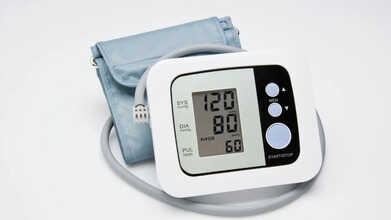- Health Conditions A-Z
- Health & Wellness
- Nutrition
- Fitness
- Health News
- Ayurveda
- Videos
- Medicine A-Z
- Parenting
- Web Stories
No Surgery Needed: How To Avoid Loose Skin When You Are Losing Weight?

Credits: Freepik
When you picture your post-weight-loss transformation, you probably see yourself as a healthier, more energetic yourself—not as someone struggling with excess folds of loose skin. For many people, the thought of loose skin is a surprising—and unwanted—consequence that takes away from the gratification of reaching their health milestones. But the good news is: Although some level of skin laxity is unavoidable, it doesn't have to lead you to surgical treatments. Through intelligent planning and targeted lifestyle modification, and a science-supported methodology, you can easily minimize your chances of getting skin that's loose—and quite possibly eliminate it altogether.
Skin is not a surface organ—it's your body's largest and most intricate barrier, comprised of collagen and elastin, proteins that are responsible for firmness and elasticity. When you put on pounds, your skin stretches to keep up with added fat reserves. But constant stretching, particularly in instances of obesity or pregnancy, may ruin these supportive fibers.
This damage is the reason why the skin tends to struggle to recover following extreme weight reduction. And although genetics and age are factors, how much weight you lose, how you care for your skin, and your diet can influence the outcome to be in your favor.
Rapid weight loss might seem appealing, but it increases the likelihood of loose skin. Losing weight slowly—ideally 1 to 2 pounds per week—gives your skin time to adjust to your body’s new shape.
According to data from the National Institutes of Health, gradual weight loss supports metabolic stability and gives your skin’s collagen fibers time to remodel rather than collapse under pressure.
Replacing lost fat with lean muscle mass gives shape and support underneath the skin. Add resistance training, weight lifting, and bodyweight exercises to your daily routine. Short sessions, performed consistently, can contribute to noticeable skin tightening in the long term.
It is particularly helpful on the arms, thighs, and stomach—areas where loose skin often manifests.
Weight loss is a great victory for your health, but unfortunately, it usually comes with a hidden cost—loose, sagging skin. While not everyone gets it, many do, particularly after fast or extreme weight loss. But the good news: loose skin doesn't necessarily mean permanent. With the right approach—from determining the cause to selecting targeted treatments—you can enhance the elasticity and look of your skin. Here's how.
First, Identify: Is It Actually Loose Skin or Stubborn Fat?
Before diving into solutions, it's worth considering whether what you're observing is actually loose skin or merely a layer of subcutaneous fat under the skin.
Test the pinch test:
Pinch the area in question gently.
If the skin is thick (over several millimeters), it's probably subcutaneous fat. If that's the case, additional fat loss may tighten the skin naturally.
If the skin is thin and wrinkly, you’re dealing with true loose skin.
Step-by-Step Guide To Tighten Loose Skin After Weight Loss
1. Nourish Your Skin from Within
Your skin relies on nutrients—especially collagen and elastin—to maintain its firmness and elasticity. A well-rounded, vitamin-rich diet can help your skin recover.
Vitamin A (for cell repair): Found in eggs, cheese, oily fish, yogurt, and fortified spreads.
Vitamin C (to produce collagen): In citrus fruits, broccoli, strawberries, and potatoes.
Vitamin E (to give skin elasticity): In nuts, seeds, vegetable oils (such as sunflower or olive), and leafy green vegetables.
A balanced diet also supports weight management and overall health.
2. Adopt Lifestyle Habits That Promote Healthy Skin
Unhealthy habits can fight against your skin's resilience.
Quit smoking: Smoking significantly cuts collagen production and speeds up skin aging.
Shield from sun damage: Too much sun exposure degrades proteins in the skin, resulting in sagging skin years later.
3. Drink Plenty of Water and Moisturize Regularly
Water isn't only necessary for losing weight—it's also important for skin elasticity.
Hydration increases elasticity: Researchers found that drinking more water enhances the texture and function of the skin.
Moisturize every day: Apply creams containing natural oils (such as olive oil or coconut oil) and collagen-enhancing agents. This will work to minimize stretch marks and keep skin from drying out and sagging.
4. Exercise To Build Back Underlying Muscle
Loose skin typically occurs when fat is lost, but underlying muscle is not gained to occupy the space. Specifically targeted strength training can turn that around.
Weight training and resistance exercises create muscle, particularly in the arms, abdomen, and thighs.
Even a daily 30-minute workout of strength-building activity can tighten skin by adding depth underneath it.
5. Investigate Non-Surgical Skin Tightening Procedures
For those in need of quicker results, some non-surgical procedures provide effective, safe solutions without going under the knife:
Ultrasound skin tightening: Utilizes sound waves to increase collagen production.
Radiofrequency and IPL (Intense Pulsed Light): Stimulate tightening of the skin and enhance texture.
Chemical peels and ablative laser resurfacing: Rejuvenate the skin surface by stimulating new skin cell growth.
Neuromodulators: Cosmetically used often to relax lines, but can also enhance skin tone and texture.
All of these treatments usually need multiple sessions and little time off work.
6. Surgery for Excess or Severely Loose Skin
If your skin has been stretched out considerably—such as following weight loss of 100 pounds or more—non-surgical treatments might not be sufficient.
Body-contouring surgeries are used to remove loose skin and fat, providing immediate and striking results:
- Tummy tuck (abdominoplasty)
- Thigh lift
- Brachioplasty (arm lift)
- Body lift
- Breast lift
Note: Always see a board-certified plastic surgeon and consider the pros, cons, and recovery time before going ahead.
Will Loose Skin Go Away On Its Own?
That is dependent upon various factors:
Age: Younger skin is more elastic.
Duration of obesity: The longer the skin has been stretched, the more difficult it can be to retract.
Lifestyle: Smoking, sun exposure, lack of nutrition, and crash diets all impact results.
For mild to moderate loose skin, regular care can result in slow improvement. For severe cases, medical treatments might be required.
When Surgery Is the Only Option
In severe instances—particularly following weight loss of more than 100 pounds—non-surgical solutions might not be enough. Body-contouring procedures like tummy tucks, thigh lifts, or brachioplasty can eliminate major folds of loose skin.
Surgery must be the last option. It's costly, involves considerable downtime, and has inherent risks. Always see a board-certified plastic surgeon and consider the advantages carefully.
Will Loose Skin Go Away on Its Own?
Mild skin laxity tends to improve on its own over time, particularly in those who are younger or who live a healthy, collagen-prompting lifestyle. But for more severe sagging, this may level off and not get any better without doing anything.
You can act proactively from day one on your weight loss program. Add skin-care measures to your fitness and diet plan and get better long-term results.
The road to a healthier body doesn't need to mean sacrificing your confidence. By gradually losing weight, nourishing your skin through nutrients and water, remaining active, and eschewing harmful habits, you give your skin the power to cope and remain resilient. Loose skin can be a widespread issue, but one that's not set in stone. With the right science-driven strategy, you can safeguard your skin—no knife necessary.
PCOS Could Be Raising Your Risk of Diabetes, Here’s The Hidden Link

Credits: Canva
Polycystic Ovary Syndrome (PCOS) is a common condition marked by the development of small cysts on the ovaries. This can interfere with ovulation, disrupt menstrual cycles, and impact fertility. Interestingly, many individuals with PCOS also experience insulin resistance, a condition where the body produces insulin, a hormone that regulates blood sugar but cannot use it effectively.
This raises concerns about a potential connection between PCOS and diabetes. We got in touch with Dr Tripti Sharan, Director of Obstetrics and Gynaecology at BLK-Max Super Speciality Hospital, explaining how PCOS may increase the risk of developing type 2 diabetes.
How PCOS Can Increase Diabetes Risk
Dr. Tripti explains that in PCOS, the ovaries do not function normally. Follicles are often stuck at different stages of development, giving the ovaries their characteristic “polycystic” appearance. However, the ovaries are not the underlying cause; they are affected by conditions like insulin resistance or hypothyroidism.“Insulin resistance is often driven by genetics, obesity, and lifestyle factors,” Dr Tripti notes. “To maintain normal blood sugar, the body produces more insulin. Excess insulin then affects the ovaries, causing them to release higher levels of male hormones. This can lead to irregular periods, acne, abnormal hair growth, and sometimes infertility.”
If these factors are left unaddressed, insulin resistance can worsen. Over time, the body struggles to regulate blood sugar effectively, potentially leading to diabetes.
Risk Factors for Diabetes in Women with PCOSPCOS is often seen as a pre-diabetic condition. Without proper management, it can progress to diabetes. Dr Tripti highlights the importance of lifestyle measures, such as maintaining a healthy weight, eating a balanced diet, managing stress, and adopting a structured daily routine.
ALSO READ: PCOS Awareness Month: 5 Lifestyle Tips To Manage PCOS According To Gynecologist
PCOS is also linked to other health concerns, including high triglycerides, fatty liver, endometrial hyperplasia, and high blood pressure. Factors such as obesity, inactivity, chronic stress, high cholesterol, pregnancy, aging, smoking, vitamin D deficiency, and misuse of steroids can further increase diabetes risk in women with PCOS.
Symptoms Indicating Higher Diabetes Risk
Signs that may indicate a higher risk of developing diabetes in PCOS include poor weight control, fatty liver, elevated lipid levels, and hormonal imbalances like excess androgens. These factors point to worsening insulin resistance, which significantly raises the likelihood of developing type 2 diabetes.Preventive Measures and Lifestyle Tips
Dr. Tripti recommends several strategies to reduce the risk of diabetes in women with PCOS:- Maintain a healthy weight
- Engage in daily physical activity, regardless of body size
- Manage stress effectively
- Prioritize sufficient sleep
- Address hormonal imbalances under medical supervision
- Treat thyroid disorders
- Monitor and control lipid levels to prevent cardiovascular issues
- Ensure pregnancies are planned and screened for diabetes
ALSO READ: Lori Harvey Opens Up About Endometriosis Journey, Shares What Brings Her Relief
She also advises focusing on a balanced diet rich in fiber, fruits, and vegetables, especially those with skins, which have a lower glycemic load. Adequate calcium and vitamin D intake are important, and regular exercise, including cardio, strength training, stretching, and relaxation practices like yoga and meditation can help manage both PCOS and diabetes risk. Additionally, avoiding smoking and limiting alcohol supports overall health.
Wellness Report: 1 In 10 Employees Sleep-Deprived, Young Workforce Faces Rising Health Risks

Credits: Canva
In today’s hyper-connected, always-on work culture, long hours and erratic shifts are quietly eating into one of the most essential pillars of health.. A new study by Truworth Wellness, India Workplace Wellbeing Report 2025: From Access to Outcomes, reveals how sleep deprivation, chronic diseases, and poor preventive care are undermining employees during their prime working years.
Sleep Deprivation: A Silent Productivity KillerThe report, based on health data from over 46,000 employees across industries, found that nearly 1 in 10 workers suffer from sleep disorders, most of them between ages 23 and 39. This lack of rest translates to 11.3 lost workdays per employee every year, costing companies an estimated ₹2.1 lakh annually, as per the study.
Chronic Conditions Striking Earlier
Cardiac issues, diabetes, and thyroid disorders are no longer diseases of old age. They are increasingly showing up in employees under 40, adding long-term pressure on both workers’ health and company healthcare costs.Obesity and the Prevention Gap
Obesity is emerging as a ‘gateway’ condition, with 14% of employees obese, 71% of them in the 25–35 age bracket. Despite being the most vulnerable, younger employees are also least likely to undergo preventive screenings, delaying early detection of high-risk conditions.Poor Sleep Is Leading To Poor Mental Health
The report also warns of the mental health toll of sleeplessness. Chronic fatigue, stress, and unmanaged conditions fuel declining resilience and rising emotional distress at work. As Rajesh Mundra, Founder and Executive Chairman of Truworth Wellness, notes, “Wellness can no longer be a checkbox activity, it must be embedded as a strategic business priority.”ALSO READ: High, Low, or Normal? A Simple Guide To Understanding Blood Pressure Readings
How Companies Can RespondTo tackle the crisis, the World Health Organization (WHO) recommends:
- Training managers to recognize and respond to emotional distress.
- Mental health literacy programs to reduce stigma and raise awareness.
- Stress management and lifestyle interventions such as physical activity and psychosocial support.
The Business Case for Better Sleep
Companies that invest in outcome-driven wellness programs already see 28% fewer sick leaves, 26% lower healthcare costs, and 11% higher revenue per employee. For every rupee spent, organizations save ₹289 in healthcare costs and ₹241 through reduced absenteeism.A Wake-Up Call for Corporate Industries
As sleep deprivation silently chips away at productivity, Indian businesses have an opportunity to treat wellness not as an add-on but as a strategic advantage. By tackling sleep, stress, and preventive care, organizations can build healthier, more resilient, and ultimately more productive workplaces.ALSO READ: Prediabetes: How To Spot the Silent Warning Signs Before It Turns Into Type-2 Diabetes
By moving beyond generic wellness programs and focusing on measurable outcomes, Indian organizations can turn employee health into a strategic advantage. Embedding sleep, stress management, and preventive care into workplace wellness not only improves productivity but also builds a resilient workforce. The Truworth Wellness India Workplace Wellbeing Report 2025, conducted in collaboration with People Matters, highlights these insights and provides a roadmap for companies to act before small health risks escalate into costly chronic conditions.
High, Low, or Normal? A Simple Guide To Understanding Blood Pressure Readings

Credits: Canva
Half of all American adults have high blood pressure, also called hypertension, yet many don’t even know it. High blood pressure occurs when blood flows through your arteries at higher-than-normal pressures. Recently, cases of high blood pressure have been rising rapidly in the U.S. and globally. As these numbers climb, regularly checking your blood pressure becomes essential.
According to the 2025 American Heart Association Statistical Update, nearly half of U.S. adults, around 122 million people, have high blood pressure, a leading preventable cause of heart disease, stroke, and early death. Shockingly, only about one in four have their condition under control. To help you stay on top of your numbers, here’s a detailed guide to understanding blood pressure.
Blood Pressure Readings ExplainedBlood pressure is written as two numbers separated by a slash, such as 120/80 mm Hg, which can be read as “120 over 80 millimeters of mercury.”
The first number, or systolic pressure, measures the force of blood against artery walls when the heart pumps.
The second number, or diastolic pressure, measures the pressure when the heart rests between beats.
ALSO READ: World Lung Day 2025: How Strong Are Your Lungs? Do These Tests To Find Out
Blood pressure naturally changes throughout the day depending on activity, stress, and other factors. A healthy reading is less than 120/80 mm Hg. Blood pressure is considered high when systolic readings are 130 mm Hg or higher or diastolic readings are 80 mm Hg or higher.
New Blood Pressure Guidelines by the American Heart Association
In August 2025, the AHA and ACC updated blood pressure guidelines to emphasize early intervention and personalized care. Key points include:- Earlier Treatment: People with a 10-year cardiovascular risk of 10% or more are advised to start medication along with lifestyle changes.
- Personalized Risk Assessment: Doctors may use the PREVENT™️ calculator to estimate 10-year risk of heart attack, stroke, or heart failure.
- Expanded Lab Testing: Tests such as the urine albumin:creatinine ratio help tailor treatment plans.
- Lifestyle First: Limit sodium intake to 1,500 mg per day, maintain a healthy weight, and stay physically active.
- Alcohol Limits: Men: 2 drinks/day; women: 1 drink/day.
Blood Pressure Monitoring
The American Heart Association recommends that everyone with high blood pressure monitor their readings at home. Home monitoring helps healthcare professionals track whether treatments are effective and can also help confirm a diagnosis of high blood pressure. However, it does not replace regular doctor visits, and you should never stop taking prescribed medication without consulting your healthcare provider, regardless of your home readings.ALSO READ: This Small Mistake Can Change Your Blood Pressure Reading, According To Doctor
Home monitoring is particularly important for:
- Anyone already diagnosed with high blood pressure.
- People starting or adjusting high blood pressure treatments, to see if they are working.
- Individuals who require closer monitoring, especially those with risk factors for high blood pressure or related health conditions.
© 2024 Bennett, Coleman & Company Limited

